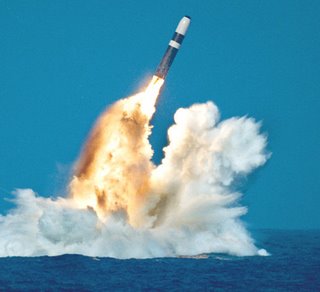
Posted by John Keller
Submarines are back in the news today with word that India is developing a nuclear-capable missile that can be launched from a submerged submarine.
I don't know what this exactly means for the regional balance of power in and around the Indian Ocean, but Pakistan -- a sworn and nuclear-armed enemy of India -- reportedly is alarmed at these developments.
The missile that India plans to integrate into a missile submarine it has under construction, the K-15, reportedly has a top range of 438 miles, which would put a growing number of areas in and around the Indian ocean within its range.
The story about India's nuclear submarine ambitions appeared today in Spacewar.com in a story entitled India to test submarine-based missile. A story confirming the upcoming tests appears in the Indian online publication newKerala.com. Writes Spacewar.com:
If the test is successful, India will be capable of launching missiles from air, land, ships and submarines, and it will join an elite group that includes the United States, Russia, France and China, experts said. The announcement comes two months after India's chief military scientist M. Natarajan said that New Delhi would test a ballistic missile with a range of 6,000 kilometres (3,800 miles) in 2008. [S. Prahlada, chief controller of India's Defence Research and Development Organisation (DRDO)] said the K-15 missile, following its experimental launch, will be "integrated" with a nuclear-powered submarine that India is building. He also said DRDO scientists would carry out another test of the 4,000-kilometre (2,480 miles) range Agni-III ballistic missile, which could hit targets deep inside China.
India has one of the most sophisticated submarine fleets in the region, with what experts believe are 12 to 15 undersea vessels. In addition, India has six diesel-electric submarines on order -- at least three of which are expected to have super-quiet air-independent propulsion (AIP) systems that render them as quiet as advanced U.S. nuclear attack submarines. Maybe even quieter.
India rival Pakistan, meanwhile, also has a sophisticated submarine fleet. That country has at least eight submarines, four diesel-electric French Daphne-class submarines purchased in the 1970s, two French Agosta-class diesel-electric submarines, and two advanced French Agosta 90B-type quiet diesel-electric submarines that could be improved even more with AIP.
Adding to the mix is South Africa on the western fringe of the Indian Ocean, which completed sea-acceptance trials for its third and last German-built Type 209/1400 Mod submarine, the SAS Queen Modjadji, off the coast of Kristiansand, southern Norway. These boats are equipped with an ISUS 90-45 sonar, command and weapon control system from Atlas Elektronik of Bremen, Germany, according to a story in Aviation Week's Ares blog entitled South Africa's Submarine Flottilla is Complete.
Iran also is developing its own submarine force, but is operating relatively old diesel-electric boats and its own home-built mini-subs, and does not yet appear to be a regional submarine threat. Yet, that is.
Add this to the Israeli navy’s purchase two summers ago of two more sophisticated attack submarines, which experts say are capable of firing nuclear-tipped cruise missiles that can hit targets in Iran, and you have potent submarine mix in the region.
I'm hoping the U.S. Navy is taking these developments into consideration as its leaders plan for the next generation of anti-submarine warfare technology.
The accompanying photo is of a U.S. Trident ballistic missile launched from a U.S. Navy Ohio-class ballistic missile submarine.
No comments:
Post a Comment